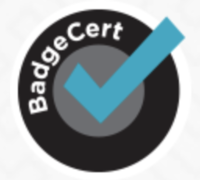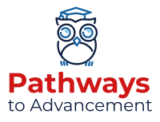The way we earn, display, and share our achievements and qualifications has evolved since the late 90s when the internet was still being discovered. No longer do we just rely on resumes or cover letters as a way to display our achievements. Digital credentials have emerged as a key tool in this evolution, offering a more convenient, accessible, and secure way to showcase our skills and accomplishments.
What are Digital Credentials?
Digital credentials are electronic records that signify the completion of a course, program, or training, or the attainment of a skill or competency. These credentials can take various forms, such as digital badges, certificates, micro-credentials, or digital diplomas/degrees. Unlike traditional paper-based credentials, digital credentials can be easily shared, verified, and managed online.
Why Are Digital Credentials Important?
Digital credentials have become increasingly important. They allow individuals to showcase their skills and accomplishments in a format that is easily shareable and verifiable, enhancing their credibility and competitiveness in the job market. Employers, educational institutions, and other stakeholders also benefit from digital credentials, as they provide a reliable way to assess an individual’s qualifications and capabilities.
Types of Digital Credentials
There are several types of digital credentials, each serving different purposes and offering varying levels of detail and verification. Here are some common types:
Digital Badges
Digital badges are visual representations of achievements, skills, or competencies earned by an individual. They can be issued for completing a course, mastering a skill, or participating in an event. Badges often contain metadata that provides details about the issuer, criteria for earning the badge, and evidence of the accomplishment. Examples include badges issued by online learning platforms like Coursera or edX, as well as badges awarded by professional organizations for specific skills or certifications.
Digital Certificates
Digital certificates are electronic documents that certify the completion of a course, program, or training. They typically include information such as the name of the recipient, the name of the issuing institution or organization, the date of issuance, and a description of the accomplishment. Digital certificates can be verified online, ensuring their authenticity.
Examples include certificates awarded by universities, training providers, or professional associations for completing a course or program.
Micro-credentials
Micro-credentials are digital credentials that focus on specific skills or competencies. They are often smaller in scope than traditional credentials, making them ideal for demonstrating proficiency in a particular area. Micro-credentials can be earned through various means, including online courses, workshops, or assessments.
Digital Diplomas/Degrees
Digital diplomas or degrees are electronic versions of traditional diplomas or degrees. They are issued by educational institutions to certify the completion of a degree program. Digital diplomas/degrees often contain embedded security features to prevent tampering and can be verified online.
Examples include digital diplomas issued by universities to graduates of their online degree programs.
These types of digital credentials offer individuals a way to showcase their achievements and skills in a format that is easily shareable and verifiable, enhancing their value in education and the workforce.
What are the Benefits of Digital Credentials?
Digital credentials offer several benefits compared to traditional paper-based credentials. Some of the key benefits include:
Accessibility: Digital credentials can be accessed and shared online, making them more convenient and accessible than paper credentials. Individuals can easily share their credentials with employers, educational institutions, or other relevant parties without the need for physical copies.
Verifiability: Digital credentials often come with built-in verification mechanisms, such as digital signatures or blockchain technology, which make it easy to verify their authenticity. This provides reassurance to employers and other parties that the credentials are legitimate.
Portability: Digital credentials can be stored and accessed on a variety of devices, including smartphones, tablets, and computers. This portability allows individuals to carry their credentials with them wherever they go, making them ideal for a globalized and mobile workforce.
Stackability: Digital credentials can be stacked or combined to create a more comprehensive picture of an individual’s skills and achievements. For example, a digital badge for completing a specific course could be stacked with a certificate for completing a related program, providing a more complete view of the individual’s qualifications.
Enhanced Security: Digital credentials are often more secure than paper credentials, as they can be encrypted and protected with passwords or other security measures. This reduces the risk of fraud or tampering.
Real-Time Updates: Digital credentials can be updated in real-time to reflect changes or additions to an individual’s skills or achievements. This ensures that the credentials are always up-to-date and relevant.
Overall, digital credentials offer a more efficient, secure, and accessible way for individuals to showcase their skills and qualifications, enhancing their value in the education and workforce sectors.
How Digital Credentials Work
Digital credentials operate through a streamlined process that encompasses issuing, verifying, and integrating them with online profiles. Understanding these processes is crucial for both credential issuers and recipients to fully leverage the benefits of digital credentials.
Issuing Process
- Issuer Identification: The process begins with an organization or institution, known as the issuer, creating a digital credential. This credential typically includes information such as the recipient’s name, the name of the credential, the date of issuance, and any relevant criteria or standards.
- Credential Creation: Once the credential is created, it is assigned a unique digital identifier, such as a cryptographic hash, to ensure its authenticity and integrity.
- Recipient Notification: The recipient is then notified of the credential and provided with access to it. This notification may be sent via email or through a credentialing platform.
Verification Process
- Verification Request: When a third party, such as an employer or educational institution, seeks to verify the credential, they send a verification request to the issuer.
- Verification Response: The issuer receives the verification request and responds with the necessary information to verify the credential. This information may include the digital identifier, the criteria for earning the credential, and any other relevant details.
- Verification Confirmation: Once the verification response is received, the third party can confirm the authenticity and validity of the credential.
Integration with Online Profiles
- Credential Display: Digital credentials can be displayed on online platforms, such as LinkedIn, to showcase an individual’s skills and qualifications.
- Linking Credentials: Individuals can link their digital credentials to their online profiles, providing viewers with direct access to the credential and its verification details.
- Enhanced Profile Visibility: By integrating digital credentials with online profiles, individuals can enhance their profile visibility and credibility, making them more attractive to potential employers or collaborators.
Overall, digital credentials offer a transparent and efficient way to verify an individual’s qualifications, benefiting both credential issuers and recipients in the digital age.
How to Earn Digital Credentials
Digital credentials can be earned through various avenues, including online courses, workshops, industry certifications, and volunteer work. Each of these methods offers individuals the opportunity to acquire new skills and demonstrate their expertise in specific areas.
Online Courses
- Selection of Courses: Choose from a wide range of online courses offered by reputable institutions and platforms. Select courses that align with your interests, career goals, or areas where you want to develop new skills.
- Course Completion: Successfully complete the online course by fulfilling all the requirements, such as attending lectures, completing assignments, and passing assessments.
- Earning the Credential: Upon successful completion, you will be awarded a digital credential, such as a certificate or badge, which signifies your achievement and can be shared with others.
Workshops and Seminars
- Participation: Attend workshops, seminars, or conferences relevant to your field of interest or profession. These events often provide valuable insights, knowledge, and networking opportunities.
- Active Engagement: Engage actively in the workshops or seminars by participating in discussions, asking questions, and interacting with other participants and speakers.
- Obtaining the Credential: Some workshops or seminars may offer digital credentials, such as certificates or badges, to participants who demonstrate active engagement and completion of the event.
Industry Certifications
- Selection of Certification: Identify relevant industry certifications that are recognized and valued in your field. These certifications can help validate your expertise and enhance your professional credibility.
- Preparation and Examination: Prepare for the certification exam by studying the required materials and gaining practical experience in the relevant areas. Take the certification exam and pass it to earn the credential.
- Certification Achievement: Upon successfully passing the exam, you will receive a digital certification, which demonstrates your proficiency in the specific area and can be shared with employers and colleagues.
Volunteer Work
- Identification of Opportunities: Look for volunteer opportunities that allow you to utilize and develop your skills in meaningful ways. Volunteer work can provide valuable experience and demonstrate your commitment to a cause or organization.
- Skill Development: Engage in volunteer work that enables you to develop new skills or enhance existing ones. This could include leadership, communication, project management, or technical skills.
- Recognition and Credentialing: Some volunteer organizations offer digital credentials or certificates to recognize the contributions and skills of their volunteers. These credentials can be valuable additions to your professional profile.
By pursuing these avenues, individuals can acquire valuable skills and knowledge while earning digital credentials that enhance their professional credentials and career prospects.
Popular Platforms for Digital Credentials
There are several popular platforms for digital credentials, each offering its own unique features and benefits. While each of these platforms offers many of the same features and functionalities, we’ll list them out for each company. Some of the most popular platforms include:
Credly by Pearson
Credly is a widely used platform for issuing and managing digital badges. It offers tools for creating, issuing, and managing badges, as well as a badge verification service. These badges represent skills, achievements, or certifications that the individual has obtained. Here’s how you can use Credly:
- Earn Badges: You can earn badges by completing courses, passing exams, or demonstrating specific skills. Organizations such as universities, companies, and professional associations issue these badges.
- Claim Your Badge: Once you’ve earned a badge, the issuing organization will typically send you an email with a link to claim your badge on Credly. Clicking this link will take you to the Credly platform, where you can create an account if you don’t already have one and claim your badge.
- Display Your Badge: After claiming your badge, you can choose to display it on your Credly profile. This profile acts as a digital resume, showcasing all the badges you’ve earned.
- Share Your Badge: You can share your badges on social media platforms, such as LinkedIn, Facebook, and Twitter, to showcase your skills and achievements to your network.
- Explore Other Badges: You can also explore badges issued by other organizations on Credly to discover new learning opportunities and professional development paths.
- Badge Support: Credly offers online support for any badge that you earn from them. Whether you have questions about how you can use your newly acquired badge or for any technical questions, Credly has their own dedicated support page making it easy for anyone who has questions.
Overall, Credly provides a convenient way to manage and showcase your skills and credentials in a digital format, making them easily shareable and verifiable.

Digital Credentials from Credly
Badgr
Badgr is another platform for issuing, managing, and sharing digital badges and credentials. Similar to Credly, Badgr allows individuals to earn badges for accomplishments such as completing courses, mastering skills, or achieving certifications.
Here’s an overview of how Badgr works:
- Earning Badges: Organizations can create badges for various achievements, and individuals can earn these badges by meeting the criteria set by the issuing organization.
- Claiming Badges: Once a badge is earned, the individual can claim it through the Badgr platform. This typically involves creating a Badgr account or logging in with an existing account.
- Displaying and Sharing Badges: Badgr provides tools for displaying earned badges on social media profiles, websites, or in email signatures. This allows individuals to showcase their skills and achievements to others.
- Badge Management: Badgr allows individuals to manage their badges, including storing them in a central location, viewing the criteria for earning each badge, and accessing any associated evidence or documentation.
- Badge Issuing: Organizations can use Badgr to issue badges to individuals, track badge issuance and engagement, and manage their badge programs.
Badgr is designed to make it easy for organizations to create and manage digital badge programs, and for individuals to earn, manage, and share their badges in a way that is portable and verifiable.

Digital Credentials from Badgr
Accredible
Accredible is a platform that specializes in issuing digital certificates, badges, and blockchain credentials. It allows organizations to create, manage, and issue digital credentials to individuals. Here’s an overview of how Accredible works:
- Credential Creation: Organizations can use Accredible to create digital certificates and badges for various achievements, such as completing courses, passing exams, or mastering specific skills.
- Issuing Credentials: Once a credential is created, organizations can issue it to individuals who have earned it. This is typically done through email, where recipients receive a link to view and claim their digital credential.
- Claiming Credentials: Recipients can claim their digital credentials by creating an account on the Accredible platform or logging in with an existing account. Once claimed, the credential is stored in their Accredible account.
- Displaying and Sharing Credentials: Accredible provides tools for recipients to display their digital credentials on social media profiles, websites, or in email signatures. This allows them to showcase their achievements to others.
- Credential Verification: Accredible credentials are designed to be verifiable, meaning that anyone can verify the authenticity of a credential by clicking on a verification link provided with the credential.
- Blockchain Credentials: Accredible offers the option to issue credentials as blockchain credentials, which are cryptographically secure and tamper-proof. This provides an additional layer of security and trust for digital credentials.

Digital Credentials from Accredible
Open Badges
Open Badges is an open standard developed by the Mozilla Foundation for recognizing and verifying skills, achievements, and credentials. The Open Badges standard allows for the creation, issuance, and sharing of digital badges across the web.
Here’s an overview of how Open Badges work:
- Badge Creation: Organizations or individuals can create digital badges using the Open Badges standard. These badges can represent a wide range of achievements, from completing a course to acquiring a specific skill.
- Badge Issuance: Once a badge is created, it can be issued to individuals who have earned it. This is typically done through a badge issuer, who verifies that the recipient has met the criteria for earning the badge.
- Badge Display: Recipients can display their badges on websites, social media profiles, or in online portfolios. Open Badges are designed to be easily shareable and verifiable.
- Badge Backpack: Open Badges can be stored in a digital “backpack,” which is a centralized repository for all the badges an individual has earned. The backpack allows individuals to manage and share their badges across different platforms.
- Badge Verification: Open Badges are designed to be verifiable, meaning that anyone can verify the authenticity of a badge by clicking on it. This verification process includes information about the badge issuer, the criteria for earning the badge, and the date it was issued.
Overall, Open Badges provide a way to recognize and showcase skills and achievements in a digital format that is portable, shareable, and verifiable across the web.

Digital Credentials from Open Badges
LinkedIn offers a feature called “LinkedIn Certifications” where users can add certifications and courses to their profile. While not a dedicated platform for digital credentials, LinkedIn is widely used for professional networking and showcasing qualifications.
LinkedIn does not directly support the issuance or display of digital credentials using the Open Badges standard. However, you can manually add your digital credentials to your LinkedIn profile in the form of certifications, licenses, or courses. Here’s how you can do it:
Step 1: Add a Certification
- Go to your LinkedIn profile and click on the “Add profile section” button.
- Select “Licenses and Certifications” from the dropdown menu.
- Enter the details of your certification, including the name, issuing organization, and date of completion.
- You can also add a URL to your digital credential if it is hosted on a platform that provides a verification link.
Step 2: Add a Course
- Follow the same steps as above but select “Courses” from the dropdown menu.
- Enter the details of the course, including the name, provider, and completion date.
- If your digital credential includes a verification URL, you can add it to the description or in the “Credential URL” field if available
Step 3: Add a License
Similarly, you can add professional licenses or certifications to your profile under the “Licenses and Certifications” section.
While LinkedIn does not directly support the Open Badges standard, you can still use it to showcase your digital credentials by adding them manually to your profile. Make sure to provide as much detail as possible to ensure the credibility of your credentials.
BadgeCert
BadgeCert is a digital credentialing platform that focuses on providing secure and verifiable digital badges and certificates. It offers a range of features for both issuing organizations and badge earners. Here are some key aspects of BadgeCert.
- Issuing Badges and Certificates: BadgeCert allows organizations to create and issue digital badges and certificates for various achievements, such as completing courses, passing exams, or acquiring skills.
- Verification: BadgeCert badges and certificates are verifiable, meaning that anyone can verify the authenticity of a badge by clicking on it. This verification process includes information about the badge issuer, the criteria for earning the badge, and the date it was issued.
- Badge Display and Sharing: Recipients can display their badges and certificates on social media platforms, websites, or in email signatures. BadgeCert provides tools for sharing badges and certificates easily.
- Security: BadgeCert emphasizes security and ensures that digital badges and certificates are tamper-proof and cannot be forged. This is important for maintaining the credibility of the credentials.
- Analytics: BadgeCert provides analytics and reporting features for organizations to track the issuance and usage of badges and certificates. This helps organizations monitor the effectiveness of their credentialing programs.
BadgeCert is designed to provide a reliable and secure platform for issuing and managing digital badges and certificates, helping organizations and individuals showcase skills and achievements in a digital format.

Digital Credentials from BadgeCert
Overall, these platforms are popular choices for individuals and organizations looking to issue and manage digital credentials, offering a range of features to meet various needs and requirements.
Digital Credentials in the Workforce
Digital credentials are transforming the way hiring practices are conducted, offering numerous advantages for both job seekers and employers. Additionally, they are increasingly being used in employee development programs to enhance skills and knowledge.
Impact on Hiring Practices
- Skill-based Hiring: Employers are shifting towards skill-based hiring, focusing more on an individual’s demonstrated skills and competencies rather than just formal education or previous experience.
- Efficient Candidate Screening: Digital credentials allow employers to quickly and efficiently screen candidates based on their verified skills and achievements, streamlining the hiring process.
- Increased Credibility: Job applicants with verified digital credentials can enhance their credibility and stand out to employers, increasing their chances of securing interviews and job offers.
Advantages for Job Seekers
- Showcasing Skills: Digital credentials enable job seekers to showcase their skills and achievements in a format that is easily accessible and verifiable, making them more attractive to employers.
- Competitive Edge: Job seekers with relevant digital credentials have a competitive edge in the job market, as they can demonstrate their qualifications more effectively than those without such credentials.
- Career Advancement: Digital credentials can help job seekers advance their careers by highlighting their ongoing professional development and commitment to learning new skills.
Use in Employee Development
- Skill Assessment: Employers can use digital credentials to assess the skills and competencies of their employees, identifying areas for improvement and development.
- Training and Upskilling: Digital credentials can be used to track employee training and upskilling initiatives, ensuring that employees are equipped with the latest skills and knowledge.
- Career Pathing: Employers can use digital credentials to map out career paths for their employees, helping them identify opportunities for advancement within the organization.
Overall, digital credentials are playing an increasingly important role in the workforce, influencing hiring practices, providing advantages for job seekers, and enhancing employee development programs. As the digital economy continues to evolve, the value of digital credentials is expected to grow, making them an essential tool for both individuals and organizations.
What are the Challenges and Concerns with Digital Credentials?
Digital credentials offer numerous benefits, but they also face challenges and concerns that need to be addressed for their widespread adoption and acceptance.
Security and Privacy
- Data Security: There are concerns about the security of the data contained within digital credentials, including personal information and the integrity of the credential itself.
- Privacy: Individuals may be concerned about the privacy implications of sharing digital credentials, such as who has access to the information and how it is used.
Standardization and Interoperability
- Lack of Standards: The lack of standardized formats and protocols for digital credentials can make it difficult to verify and compare credentials from different issuers.
- Interoperability: Without interoperability, credentials earned from one issuer may not be easily transferable or stackable with credentials from another issuer, limiting their value.
Recognition and Acceptance
- Perceived Value: Some employers and institutions may not yet fully recognize or understand the value of digital credentials, leading to skepticism about their significance.
- Verification Challenges: Verifying the authenticity and validity of digital credentials can be challenging, especially when there are no widely accepted standards or systems in place.
Efforts are underway to address these challenges and promote the wider adoption of digital credentials. Initiatives such as the Open Badges standard and blockchain technology aim to establish common frameworks for issuing and verifying digital credentials, improving their security, standardization, and recognition. As digital credentials continue to evolve, addressing these challenges will be crucial to realizing their full potential in the digital age.
The Future Trends in Digital Credentials
The future of digital credentials is poised to be shaped by several key trends. Blockchain technology, with its decentralized and secure nature, is revolutionizing the way credentials are issued, stored, and verified. Personalized learning pathways are also becoming more prevalent, allowing learners to tailor their educational experiences to their specific needs and goals. Additionally, global recognition frameworks are emerging to standardize the recognition and acceptance of digital credentials across borders. These frameworks aim to enhance the portability and value of credentials, making them more valuable in an increasingly globalized world. Now we’ll go into more detail about these up-and-coming trends.
Blockchain Technology
Blockchain technology offers a decentralized and secure way to store and verify digital credentials. Each credential is recorded on a blockchain, ensuring its authenticity and preventing tampering. This technology enables individuals to have greater control over their credentials, allowing them to share only the information necessary for a particular purpose. For example, a job applicant could provide a potential employer with access to their credentials for verification without revealing sensitive personal information. Blockchain also enables the creation of verifiable digital badges, which can represent specific skills or achievements and be easily shared online.
Personalized Learning Pathways
Personalized learning pathways cater to individual learners’ needs, interests, and goals. Instead of following a one-size-fits-all approach, learners can choose their educational experiences based on their specific requirements. This could include selecting courses, projects, and experiences that align with their career aspirations or areas of interest. Personalized learning pathways are often facilitated by technology, which can track learners’ progress, suggest relevant resources, and provide feedback to help them achieve their learning objectives more effectively.
Global Recognition Frameworks
As digital credentials become more prevalent, there is a growing need for standardization and recognition across borders. Global recognition frameworks aim to establish common standards for the issuance and recognition of digital credentials, making them more portable and valuable internationally. These frameworks facilitate the transferability of credentials between different educational institutions and countries, enabling individuals to pursue further education or employment opportunities abroad more easily. Examples of global recognition frameworks include the European Qualifications Framework (EQF) and the Asia-Pacific Regional Convention on the Recognition of Qualifications in Higher Education (Tokyo Convention).
These trends are expected to significantly impact the future of education and workforce development, making it easier for individuals to acquire and showcase their skills and achievements in a digital world.
Embracing the Future of Digital Credentials
As the digital economy continues to grow, digital credentials are expected to play an increasingly important role in education, employment, and professional development. Whether you’re a job seeker looking to stand out to employers or an organization seeking to enhance your employee development programs, understanding digital credentials is essential in navigating the digital landscape of the future.



